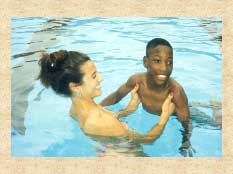|
News Updates:
- News from APENS (Adapted PE National Standards):
Dr. Ron French from TWU has just finished his three-year term as
the APENS director. The new director/coordinator for the next three
years is: Dr. Tim Davis.
So, the APENS office has moved from Texas to New York; specifically,
to the State University of New York-Cortland, with Tim Davis. The
web address, for the near future, will remain as is at: www.twu.edu/o/apens
When a new address is established; people can link to it from the
present (old one).
Remember, this is YOUR national certification in the field of Adapted
Physical education. Make the most out of your job and your profession;
take the test; become a CAPE (certified adapted physical educator).
- On-Line Assistive Technology training and competency certifications
Go to: www.NASDSE.org for more
information; or call (888) 438-1938.
- Disabled Sports USA: One of many organizations dedicated to improving
the lives of those with disabilities, especially via the sports
world. This is a terrific organization which promotes the development
of, and access to, sports for people with disabilities. It assists
these individuals, their families, and their coaches. It especially
focuses on individual sports. Kirk Bauer, J.D., is the Executive
Director. A Vietnam Vet, he lost his leg in war; he, himself, owns
multiple medals competing in track competitions with a prosthesis;
he can offer guidance and instruction on the newest technology available
for sport prostheses. For more information, check out: www.dsusa.org
The Slogan for DS-USA is:
"IF I CAN DO THIS, I CAN DO ANYTHING!"
What a great message to all of us, to remind us all of the value
we bring to this field! Keep up the great work, all you , in the
field of adapted physical activity!
OR, visit the homepage of an excellent journal in the field: www.Palaestra.com
for information on DS-USA and the many other excellent (official U.S.
Olympic member) organizations promoting sports for people with disabilities.
Chris Stopka
Adapted Section Editor
|
|
Using Adapted Aquatics Equipment to Facilitate
the Acquisition of Aquatics Skills by Students with Disabilities
Christine Stopka, Ph.D., ATC/L, CSCS, CAPE, MTAA;
John Todorovich, Ph.D., Paul Malczak, B.S,
University of Florida
With appropriate supervision, affordable adapted aquatics equipment
can be used to facilitate students' learning of specific aquatics
skills, as well as those helpful for improving their activities of
daily living. For example, (1) the forward overhand arm motion needed
to throw a ball for an aquatics target game is similar to the arm
motion needed for the crawl/freestyle stroke. Also, (2) the buoyancy
and resistance of just the water, itself, can facilitate the skill
of walking to help students walk more independently on land. (3) Blowing
games, such as blowing colorful ping-pong balls across the water's
surface, facilitate crucial aquatics breath control skills. (4) Underwater,
breath-holding skills are enhanced by practice, and students are especially
motivated to do so by offering them enticing toys to reach for that
have sunk to the pool bottom.
These equipment ideas are exciting as they are easy, effective.
Learning potentials can be maximized with the use of affordable equipment
ideas; all while everyone involved is having lots of fun. The following
list details more examples of these techniques.
Specific examples of how the use of adapted aquatics equipment can
of help facilitate the learning of aquatics skills, and more. Please
see the following two columns to the right for specific examples.
|
|
 |
- When using a competition pool with virtually no "shallow"
end, a sinkable table can be placed against the wall of the pool,
thus making a five foot deep shallow end closer to 1 ½ to
2 feet deep; this invites easy entry, exit, and a host of other
games (touching painted figures on the table surface, thus getting
face wet, etc., all the way to the surface serving as home plate
in a water baseball game, or a launch pad for kids to jump into
your arms!)
- Folded gym mats make for great (but slower and safe) "sliding
board" entries into the pool.
|
| Water
exploration/breath control skills |
- The above table for the shallow end in deeper pools entices enthusiastic
activity in this area.
- Use ping-pong balls to blow across the surface for teaching exhalation.
- Colorful, plastic, Easter eggs can be filled with varying amounts
of water to allow them to stay on the surface (empty), sink slowly
(partially filled), or sink quickly (completely filled) for easy
to more challenging retrieval to facilitate underwater movement
and breath control skills.
|

| Gross
motor (walking, etc.,) balance skills, fitness in water |
- Standing in chest deep water provides the most balance and support,
without the fear of the water being too close to the face (helpful
for newer swimmers, and some with motor disabilities).
- Walking in chest deep water allows for balance and support, but
enough resistance to work on strength and endurance (fitness) for
improved land walking later.
- The faster one moves their limbs, or whole body, through the water,
the more resistance that is given by the water, thus improving strength.
- Water dumbbells and kick sticks made from PVC pipe (or broom sticks)
and fun noodles or empty two liter soda bottles, provide terrific
exercise equipment at virtually no cost.
- PVC parallel bars, with holes to sink the bars, can be used offer
walking and other arm strength activities to the participant for
fun and fitness.
|

- Lepore, Stevens & Gayle. Adapted Aquatics Programming: A Professional
Guide, Human Kinetics, 1998.
- CRCS, Adapted Aquatics: Promoting Aquatic Opportunities for All,
Canadian Red Cross Society, 1986.
- Stopka, Christine. (2001). "Adapted equipment ideas to enhance
your aquatics program; Part 1: New twists to conventional equipment,"
Palaestra, Volume 17, #1, Winter, pp. 36-43.
- Stopka, Christine. (2001). "Adapted equipment ideas to enhance
your aquatics program; Part II: Unique equipment ideas," Palaestra,
Volume 17, #2, Spring, pp. 40-43.
- Stopka, Christine. (2001). "Adapted equipment ideas to enhance
your aquatics program; Part III: But Where's the Pool?" Palaestra,
for Volume 17, #3, Summer, pp. 39-43.
- Stopka, Christine and Lorilynn Bowie. (2000). Adapted Equipment
Ideas to Facilitate Inclusionary Teaching, 2nd Ed., Burgess Co.
Publishers, Minneapolis, MN, 74 pp.
|

| If you have ideas, comments, letters to share, or questions
about particular topics, please email one of the following Adapted PE
Section Editors: |
|
 |
| Floating
skills & changing positions (eg., horizontal to vertical; prone
to supine, etc.) |
- These skills can be facilitated through the use of kickboards
and kick sticks (above), and even fun, inflatable toys to be used
as kick boards, in water shallow enough to stand in for safety.
- Noodles offer a variety of ways for the swimmer to use them for
support for prone, supine, and even vertical floating.
- Empty, plastic, gallon sized milk jugs, tied with a scarf or similar
comfortable connector can be used to give shoulders, chest, waist,
thighs, buoyancy in supine or prone floating positions.
- Providing a pool full of enticing toys will motivate new swimmers
to move to retrieve a desired toy, which enhances their abilities
to change directions without thinking about it (ie., supervised
"chaos" can often help a child forget unfounded fears,
and launch themselves for their toy of choice; obviously, direct
supervision is assumed for safety).
|
| Propulsion
skills (kicking skills and arm strokes) |
- Ball throwing games, especially those encouraging the overhand
throw, help the child find that they are actually performing the
crawl/freestyle stroke arm action, virtually by throwing a ball.
- These objects can be plastic, foam, 'splash' balls, plastic eggs,
anything that can be thrown safely; people should never be allowed
to be targets; softer, lighter balls require a more pronounced throwing
action, which results in improved throwing skills, but more importantly,
arm propulsion for swimming occurs with each solid throw.
- The above mentioned kick sticks can be used for more than water
fitness; they are excellent as kickboards, long enough to accommodate
more than one kicker; so buoyancy is provided to practice individual,
and team, kicking skills.
|
- Reaching assists from the pool deck to someone in distress can
be safely done by holding onto one end of a kick stick (the two
liter bottle/broom stick device described above), and reaching the
other end to the swimmer in need of assistance.
- The same can be done with the "rescuer" in the pool
while the rescuer secures a free hand to a pool ladder, lane line,
or similar hand-hold to ensure the safety and security of the rescuer.
TABLE 1 offers a detailed summary of the above, and more, in tabular
form. Please click here
to view table.
The pictures below capture the fun and pride of several young students
learning aquatics skills.


|

|



